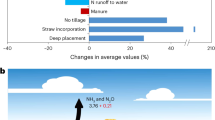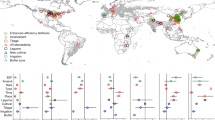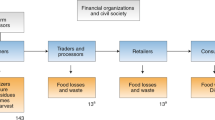Abstract
China’s gains in food production over the past four decades have been associated with substantial agricultural nitrogen losses, which contribute to air and water pollution, greenhouse gas emissions and damage to human health. Here, we explore the potential to improve agricultural production practices that simultaneously increase yields while addressing these environmental challenges. We link agronomic research with air quality modelling for an integrated assessment of four improved nitrogen management strategies: improved farm management practices with nitrogen use reductions; machine deep placement of fertilizer; enhanced-efficiency fertilizer use; and improved manure management. We find that simultaneous implementation of the four strategies provides the largest benefits, which include: reductions in PM2.5 concentrations and associated premature deaths; increases in grain yields and grain nitrogen use efficiency; reductions in NO3− leaching and runoff and greenhouse gas emissions. Total benefits of US$30 billion per year exceed the US$18 billion per year in costs. Our findings indicate that policies that improve farmers’ agricultural nitrogen management in China will improve both food security and public health while addressing multiple environmental challenges. Similar increases in attention on agricultural policy around the world are likely to provide large benefits in food security, environmental integrity and public health.
This is a preview of subscription content, access via your institution
Access options
Access Nature and 54 other Nature Portfolio journals
Get Nature+, our best-value online-access subscription
$29.99 / 30 days
cancel any time
Subscribe to this journal
Receive 12 digital issues and online access to articles
$119.00 per year
only $9.92 per issue
Buy this article
- Purchase on Springer Link
- Instant access to full article PDF
Prices may be subject to local taxes which are calculated during checkout




Similar content being viewed by others
Data availability
The datasets generated during this study are available from Princeton University’s DataSpace repository (http://arks.princeton.edu/ark:/88435/dsp01pz50gz996). Source data are provided with this paper.
Code availability
NCAR Command Language (NCL) is used for analyses and visualizations in this study50. The NCL code is available from Princeton University’s DataSpace repository (http://arks.princeton.edu/ark:/88435/dsp01pz50gz996).
References
Shi, Y., Cui, S., Ju, X., Cai, Z. & Zhu, Y.-G. Impacts of reactive nitrogen on climate change in China. Sci. Rep. 5, 8118 (2015).
Gu, B., Sutton, M. A., Chang, S. X., Ge, Y. & Chang, J. Agricultural ammonia emissions contribute to China’s urban air pollution. Environ. Sci. Technol. 45, 168–174 (2014).
Yu, C. et al. Managing nitrogen to restore water quality in China. Nature 567, 516–520 (2019).
Cui, K. & Shoemaker, S. P. A look at food security in China. NPJ Sci. Food 2, 4 (2018).
Zhang, X. et al. Managing nitrogen for sustainable development. Nature 528, 51–59 (2015).
Galloway, J. N. et al. The nitrogen cascade. Bioscience 53, 341–356 (2003).
Bai, Z. et al. China’s livestock transition: driving forces, impacts, and consequences. Sci. Adv. 4, eaar8534 (2018).
Bai, Z. et al. Livestock housing and manure storage need to be improved in China. Environ. Sci. Technol. 51, 8212–8214 (2017).
Bai, Z. et al. Nitrogen, phosphorus, and potassium flows through the manure management chain in China. Environ. Sci. Technol. 50, 13409–13418 (2016).
Brauer, M. et al. Ambient air pollution exposure estimation for the global burden of disease 2013. Environ. Sci. Technol. 50, 79–88 (2016).
Burnett, R. et al. Global estimates of mortality associated with long-term exposure to outdoor fine particulate matter. Proc. Natl Acad. Sci. USA https://doi.org/10.1073/pnas.1803222115 (2018).
Huang, R. J. et al. High secondary aerosol contribution to particulate pollution during haze events in China. Nature 514, 218–222 (2014).
Pinder, R. W., Adams, P. J. & Pandis, S. N. Ammonia emission controls as a cost-effective strategy for reducing atmospheric particulate matter in the Eastern United States. Environ. Sci. Technol. 41, 380–386 (2007).
Banzhaf, S. et al. Impact of emission changes on secondary inorganic aerosol episodes across Germany. Atmos. Chem. Phys. 13, 11675–11693 (2013).
Megaritis, A. G., Fountoukis, C., Charalampidis, P. E., Pilinis, C. & Pandis, S. N. Response of fine particulate matter concentrations to changes of emissions and temperature in Europe. Atmos. Chem. Phys. 13, 3423–3443 (2013).
Wang, S. et al. Impact assessment of ammonia emissions on inorganic aerosols in East China using response surface modeling technique. Environ. Sci. Technol. 45, 9293–9300 (2011).
Three-Year Action Plan to Win the Battle for a Blue Sky [in Chinese] (The National Development and Reform Commission of the State Council of China, 2018); http://www.gov.cn/zhengce/content/2018-07/03/content_5303158.htm?gs_ws=weixin_636662351573937202&from=timeline&isappinstalled=0
Xia, L. et al. Can knowledge‐based N management produce more staple grain with lower greenhouse gas emission and reactive nitrogen pollution? A meta‐analysis. Glob. Change Biol. 23, 1917–1925 (2017).
Action Plan for Zero Growth of Fertilizer Consumption by 2020 [in Chinese] (Chinese Ministry of Agriculture, 2015); http://jiuban.moa.gov.cn/zwllm/tzgg/tz/201503/t20150318_4444765.htm
Action Plan for Manure Nutrient Usage (2017–2020) [in Chinese] (Chinese Ministry of Agriculture, 2017); http://www.moa.gov.cn/nybgb/2017/dbq/201801/t20180103_6134011.htm
Standard of Animal Waste Discharge to Waters (Draft Version for Public Review) [in Chinese] (Ministry of Ecology and Environment of the People’s Republic of China, 2011); http://www.mee.gov.cn/gkml/hbb/bgth/201103/W020110328492079276914.pdf
Paulot, F. & Jacob, D. J. Hidden cost of US agricultural exports: particulate matter from ammonia emissions. Environ. Sci. Technol. 48, 903–908 (2014).
Liu, M. et al. Ammonia emission control in China would mitigate haze pollution and nitrogen deposition, but worsen acid rain. Proc. Natl Acad. Sci. USA 116, 7760–7765 (2019).
Chen, X. et al. Producing more grain with lower environmental costs. Nature 514, 486–489 (2014).
Velthof, G. L. et al. The impact of the Nitrates Directive on nitrogen emissions from agriculture in the EU-27 during 2000–2008. Sci. Total Environ. 468, 1225–1233 (2014).
Zhang, L. et al. Agricultural ammonia emissions in China: reconciling bottom-up and top-down estimates. Atmos. Chem. Phys. 18, 339–355 (2018).
Seinfeld, J. H., Pandis, S. N. & Noone, K. Atmospheric Chemistry and Physics: From Air Pollution to Climate Change (American Institute of Physics, 1998).
Bobbink, R. et al. Global assessment of nitrogen deposition effects on terrestrial plant diversity: a synthesis. Ecol. Appl. 20, 30–59 (2010).
Huang, X. et al. A high-resolution ammonia emission inventory in China.Global Biogeochem. Cycles 26, GB1030 (2012).
Gu, B. J. et al. Atmospheric reactive nitrogen in China: sources, recent trends, and damage costs. Environ. Sci. Technol. 46, 9420–9427 (2012).
Kang, Y. et al. High-resolution ammonia emissions inventories in China from 1980 to 2012. Atmos. Chem. Phys. 16, 2043–2058 (2016).
Wu, L., Chen, X., Cui, Z., Zhang, W. & Zhang, F. Establishing a regional nitrogen management approach to mitigate greenhouse gas emission intensity from intensive smallholder maize production. PLoS ONE 9, e98481 (2014).
FAOSTAT Database (Food and Agriculture Organization of the United Nations, accessed 13 March 2018); http://www.fao.org/faostat/en/#data
Li, Q. et al. A new urease-inhibiting formulation decreases ammonia volatilization and improves maize nitrogen utilization in North China Plain. Sci. Rep. 7, 43853 (2017).
Strokal, M. et al. Alarming nutrient pollution of Chinese rivers as a result of agricultural transitions. Environ. Res. Lett. 11, 024014 (2016).
Lu, X. et al. Exploring 2016-2017 surface ozone pollution over China: source contributions and meteorological influences. Atmos. Chem. Phys. 19, 8339–8361 (2019).
Lin, J.-T. Satellite constraint for emissions of nitrogen oxides from anthropogenic, lightning and soil sources over East China on a high-resolution grid. Atmos. Chem. Phys. 12, 2881–2898 (2012).
Zhu, L. et al. Sources and impacts of atmospheric NH3: current understanding and frontiers for modeling, measurements, and remote sensing in North America. Curr. Pollut. Rep. 1, 95–116 (2015).
Zhu, L. et al. Global evaluation of ammonia bidirectional exchange and livestock diurnal variation schemes. Atmos. Chem. Phys. 15, 12823–12843 (2015).
Sutton, M. A. et al. Towards a climate-dependent paradigm of ammonia emission and deposition. Phil. Trans. R. Soc. B Biol. Sci. 368, 20130166 (2013).
Piao, S. et al. The impacts of climate change on water resources and agriculture in China. Nature 467, 43–51 (2010).
Erda, L. et al. Climate change impacts on crop yield and quality with CO2 fertilization in China. Phil. Trans. R. Soc. B Biol. Sci. 360, 2149–2154 (2005).
Chen, X.-P. et al. Integrated soil–crop system management for food security. Proc. Natl Acad. Sci. USA 108, 6399–6404 (2011).
Oikawa, P. et al. Unusually high soil nitrogen oxide emissions influence air quality in a high-temperature agricultural region. Nat. Commun. 6, 8753 (2015).
Riddick, S. N. et al. Estimate of changes in agricultural terrestrial nitrogen pathways and ammonia emissions from 1850 to present in the Community Earth System Model. Biogeosciences 12, 3397–3426 (2015).
Kanada, M. et al. Regional disparity and cost-effective SO2 pollution control in China: a case study in 5 mega-cities. Energy Policy 61, 1322–1331 (2013).
Zhang, W. et al. Closing yield gaps in China by empowering smallholder farmers. Nature 537, 671–674 (2016).
Development Research Center of the State Council of China & Shandong Supply and Marketing Cooperatives Scale service and modernization of agriculture: supply and marketing cooperatives in Shandong Province Exploration Theory and Practice [in Chinese] (China Development Press, 2015).
Baylis, K., Peplow, S., Rausser, G. & Simon, L. Agri-environmental policies in the EU and United States: a comparison. Ecol. Econ. 65, 753–764 (2008).
NCAR Command Language Version 6.3.0 (UCAR, NCAR, CISL & TDD, 2020); http://dx.doi.org/10.5065/D6WD3XH5
Zhang, W. et al. New technologies reduce greenhouse gas emissions from nitrogenous fertilizer in China. Proc. Natl Acad. Sci. USA 110, 8375–8380 (2013).
Wu, L. et al. Current potassium-management status and grain-yield response of Chinese maize to potassium application. J. Plant Nutr. Soil Sci. 176, 441–449 (2013).
Huang, J., Hu, R., Cao, J. & Rozelle, S. Training programs and in-the-field guidance to reduce China’s overuse of fertilizer without hurting profitability. J. Soil Water Conserv. 63, 165A–167A (2008).
Wu, L. Fertilizer Recommendations for Three Major Cereal Crops Based on Regional Fertilizer Formula and Site Specific Adjustment in China. PhD thesis, China Agricultural Univ. (2014).
Chen, X. Fertilizer Use Recommendations for China’s Three Major Crops in Their Typical Agri-Ecological Zones [in Chinese] (China Agricultural Press, 2016).
Wu, L. Nitrogen Fertilizer Demand and Greenhouse Gas Mitigation Potential Under Nitrogen Limiting Conditions for Chinese Agriculture Production. PhD thesis, China Agricultural Univ. (2014).
Wu, L., Chen, X., Cui, Z., Wang, G. & Zhang, W. Improving nitrogen management via a regional management plan for Chinese rice production. Environ. Res. Lett. 10, 095011 (2015).
Mi, G. et al. Ideotype root architecture for efficient nitrogen acquisition by maize in intensive cropping systems. Sci. China Life Sci. 53, 1369–1373 (2010).
Trenkel, M. E. Slow- and Controlled-Release and Stabilized Fertilizers: An Option for Enhancing Nutrient Use Efficiency in Agriculture (International Fertilizer Association, 2010).
Xia, L., Ti, C., Li, B., Xia, Y. & Yan, X. Greenhouse gas emissions and reactive nitrogen releases during the life-cycles of staple food production in China and their mitigation potential. Sci. Total Environ. 556, 116–125 (2016).
Chen, S., Zhang, S., Sun, X. & Li, Y. Design and experiment of self-propelled high-ground-clearance spreader for paddy variable-rate fertilization [in Chinese with English abstract]. Trans. Chin. Soc. Agricult. Eng. 28, 16–21 (2012).
Cao, Y. et al. Review on ammonia emission mitigation techniques of crop-livestock production system [in Chinese]. Sci. Agricult. Sinica 51, 566–580 (2018).
Paulot, F. et al. Ammonia emissions in the United States, European Union, and China derived by high‐resolution inversion of ammonium wet deposition data: interpretation with a new agricultural emissions inventory (MASAGE_NH3). J. Geophys. Res. Atmos. 119, 4343–4364 (2014).
Morrison, H., Curry, J. A. & Khvorostyanov, V. I. A new double-moment microphysics parameterization for application in cloud and climate models. Part I: description. J. Atmos. Sci. 62, 1665–1677 (2005).
Hong, S.-Y., Noh, Y. & Dudhia, J. A new vertical diffusion package with an explicit treatment of entrainment processes. Mon. Weather Rev. 134, 2318–2341 (2006).
Chen, F. & Dudhia, J. Coupling an advanced land surface–hydrology model with the Penn State–NCAR MM5 modeling system. Part I: model implementation and sensitivity. Mon. Weather Rev. 129, 569–585 (2001).
Li, M. et al. MIX: a mosaic Asian anthropogenic emission inventory under the international collaboration framework of the MICS-Asia and HTAP. Atmos. Chem. Phys. 17, 935–963 (2017).
Janssens-Maenhout, G. et al. HTAP_v2.2: a mosaic of regional and global emission grid maps for 2008 and 2010 to study hemispheric transport of air pollution. Atmos. Chem. Phys. 15, 11411–11432 (2015).
Guenther, A. et al. Estimates of global terrestrial isoprene emissions using MEGAN (Model of Emissions of Gases and Aerosols from Nature). Atmos. Chem. Phys. 6, 3181–3210 (2006).
Cui, Z. et al. Closing the yield gap could reduce projected greenhouse gas emissions: a case study of maize production in China. Glob. Change Biol. 19, 2467–2477 (2013).
Cui, Z. et al. Closing the N-use efficiency gap to achieve food and environmental security. Environ. Sci. Technol. 48, 5780–5787 (2014).
Zhao, Y. et al. Atmospheric nitrogen deposition to China: a model analysis on nitrogen budget and critical load exceedance. Atmos. Environ. 153, 32–40 (2017).
Gu, B. J., Ju, X. T., Chang, J., Ge, Y. & Vitousek, P. M. Integrated reactive nitrogen budgets and future trends in China. Proc. Natl Acad. Sci. USA 112, 8792–8797 (2015).
Bouwman, L. et al. Exploring global changes in nitrogen and phosphorus cycles in agriculture induced by livestock production over the 1900–2050 period. Proc. Natl Acad. Sci. USA 110, 20882–20887 (2013).
All China Marketing Research Co, China Census Data by County 2000–2010 (2014); https://chinadatacenter.net/Data/ServiceContent.aspx?id=1622
Burnett, R. T. et al. An integrated risk function for estimating the global burden of disease attributable to ambient fine particulate matter exposure. Environ. Health Perspect. 122, 397–403 (2014).
Xu, X., Chen, R., Kan, H. & Ying, X. Meta-analysis of contingent valuation studies on air pollution-related value of statistical life in China. Chin. Health Res. 1, 64–67 (2013).
Xie, X. The Value of Health: Applications of Choice Experiment Approach and Urban Air Pollution Control Strategy. PhD thesis, Peking Univ. (2011).
Nielsen, C. P. & Ho, M. S. Clearer Skies Over China: Reconciling Air Quality, Climate, and Economic Goals (MIT Press, 2013).
Chinese National Development and Reform Commission Information Summary on the Production Costs and Revenues of National Agricultural Products [in Chinese] (China Statistics Press, 2016).
Ying, H., Ye, Y., Cui, Z. & Chen, X. Managing nitrogen for sustainable wheat production. J. Clean. Prod. 162, 1308–1316 (2017).
Schiermeier, Q. Prices plummet on carbon market. Nature 457, 365 (2009).
Acknowledgements
Y.G. thanks the Princeton School of Public and International Affairs and the Graduate School at Princeton University for providing a five-year graduate fellowship and a Dean’s Completion Fellowship, respectively. L.Z. and L.M. acknowledge support from the National Key Research and Development Program of China (2017YFC0210102, 2018YFC0213304 and 2018YFC0213305) and the National Natural Science Foundation of China (41922037). W.Z. acknowledges support from the National Key Technologies Research and Development Program (grant 2016YFD0201303). We appreciate observations shared by S. Lai, Q. Yuan, J. Chen, Y. He, S. Wu and J. X. Warner, programming code for visualization shared by Y. Huang, and constructive suggestions from D. Kanter.
Author information
Authors and Affiliations
Contributions
Y.G., L.Z., T.D.S. and D.L.M. designed the study. Y.G., Y.C., M.Z., D.P. and J.Y. performed the research. L.W., Z.C., W.Z., F.Z., L.M., Y.S. and M.A.Z. contributed data and analytical tools. Y.G., T.D.S., L.Z. and D.L.M. analysed the results and wrote the manuscript.
Corresponding authors
Ethics declarations
Competing interests
The authors declare no competing interests.
Additional information
Publisher’s note Springer Nature remains neutral with regard to jurisdictional claims in published maps and institutional affiliations.
Supplementary information
Supplementary Information
Supplementary methods, discussion, Tables 1–21, Figs. 1–17 and references.
Source data
Source Data Fig. 2
Numerical data
Source Data Fig. 3
Numerical data
Rights and permissions
About this article
Cite this article
Guo, Y., Chen, Y., Searchinger, T.D. et al. Air quality, nitrogen use efficiency and food security in China are improved by cost-effective agricultural nitrogen management. Nat Food 1, 648–658 (2020). https://doi.org/10.1038/s43016-020-00162-z
Received:
Accepted:
Published:
Issue Date:
DOI: https://doi.org/10.1038/s43016-020-00162-z
This article is cited by
-
Closing the gap between climate regulation and food security with nano iron oxides
Nature Sustainability (2024)
-
Diversifying crop rotation increases food production, reduces net greenhouse gas emissions and improves soil health
Nature Communications (2024)
-
Construction of China’s food security evaluation index system and spatiotemporal evolution
Environmental Science and Pollution Research (2024)
-
The First Global Map of Atmospheric Ammonia (NH3) as Observed by the HIRAS/FY-3D Satellite
Advances in Atmospheric Sciences (2024)
-
Deciphering Soil Fertility of Tobacco Planting Fields with Back Propagation Artificial Neural Networks in Southwest China
Journal of Soil Science and Plant Nutrition (2024)



